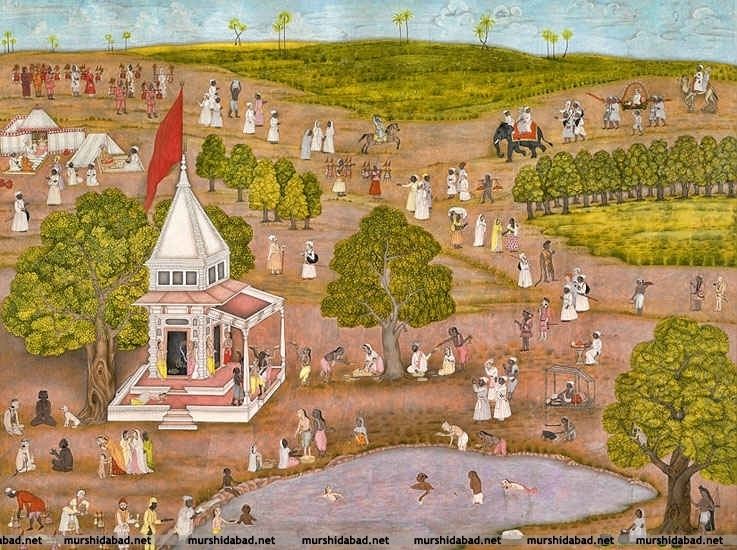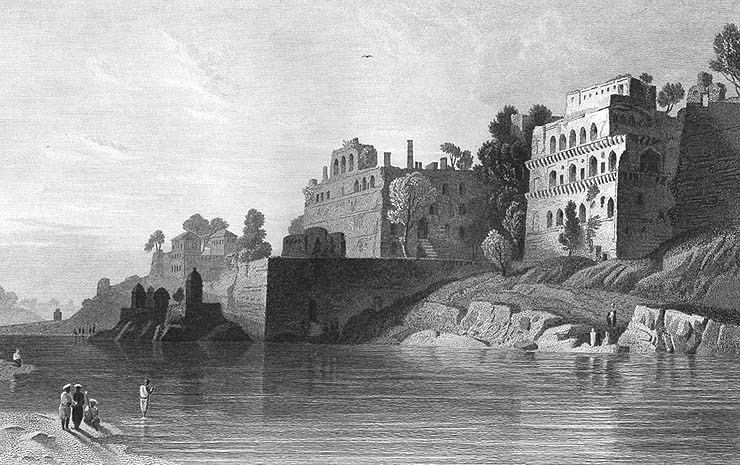Country State | District Murshidabad | |
 | ||
Colleges and Universities Dumkal College, Nagar College | ||
Languages spoken | ||
Map of Murshidabad
Murshidabad (Pron: ˈmʊəʃɪdəˌbɑ:d/bæd or ˈmɜ:ʃɪdəˌ) is a town in Murshidabad district of West Bengal state in India. The city of Murshidabad is located on the eastern bank of the Bhagirathi, a distributary of the Ganges River.
Contents
- Map of Murshidabad
- Murshidabad hazarduari palace tour
- Geography
- History
- Historic places
- Economics
- Demographics
- Educational institutes
- Training institutes
- Notable residents
- References

Murshidabad hazarduari palace tour
Geography

The District Of Murshidabad has an area of 2143 sq. m. It is divided into two nearly equal portions by the Bhagirathi, the ancient channel of the Ganges. The tract to the west, known as the Rarh, consists of hard clay and nodular limestone. The general level is high, but interspersed with marshes and seamed by hill torrents. The Bagri or eastern half belongs to alluvial plains of eastern Bengal. There are few permanent swamps; but the whole country is low-lying, and liable to annual inundation. In the north-west are a few small detached hillocks, said to be of basaltic formation.
History

Murshidabad was a town and district of British India, in the Bengal Presidency. In the Mughal period it was the capital of Bengal. The town of Murshidabad is on the left bank of the Hooghly River or main channel of the Ganges.
In 1704, Murshid Quli Khan, the Diwan of Bengal under Aurangzeb transferred the capital from Dacca (now Dhaka in Bangladesh), and renamed the city Murshidabad after his own name. In 1716, he attained the title of Nawab (ruler) of the Subah (province) of Bengal, and Murshidabad became his capital.
The family of Jagat Seth maintained their position as state bankers at Murshidabad from generation to generation. Even after the conquest of Bengal by the British, Murshidabad remained for some time the seat of administration. Warren Hastings removed the supreme civil and criminal courts to Calcutta in 1772, but in 1775 the latter courts were brought back to Murshidabad again. In 1790, under Lord Cornwallis, the entire revenue and judicial staffs were moved to Calcutta. The town was still the residence of the nawab, who ranked as the first nobleman of the province with the style of Nawab Bahadur of Murshidabad, instead of Nawab Nazim of Bengal. The Hazarduari Palace, dating back to 1837, is a magnificent building. The city still bears memories of Nawabs with other palaces, mosques, tombs, and gardens, and retains such industries as carving in ivory, gold and silver embroidery, and silk-weaving. A college was maintained for the education of the nawab's family. Rao Jogendra Narayan Roy king of Lalgola is remembered for his philanthropic work and charity.
It was constituted as a municipality in 1869, which remains to the present day.
The population in 1901 was 15,168. The major industry within the district at that time was that of silk, formerly of much importance, was revived with government assistance. The city is also famous for producing exotic mango and litchi. A narrow-gauge railway crosses the district, from the East Indian line at Nalhati to Azimganj on the Bhagirathi, the home of many rich Jain merchants; a branch of the Eastern Bengal railway was opened. Baharampur, the capital of Murshidabad, has grown in importance, population & size; as of 2011 it is the 7th largest city in West Bengal.
Historic places
While it features extensively in history books, the large potential for heritage tourism has been somewhat neglected. Of historic interest are Nizamat Kila (the Fortress of the Nawabs), also known as the Hazaarduari Palace (Palace of a Thousand Doors), built by Duncan McLeod of the Bengal Engineers in 1837, in the Italianate style, the Moti Jhil (Pearl Lake) just to the south of the palace, the Muradbagh Palace and the Khushbagh Cemetery, where the remains of Ali Vardi Khan and Siraj Ud Daulah are interred.
Hazarduari Palace is located in the campus of Kila Nizamat of Murshidabad. It was built in the nineteenth century by architect Duncan Macleod, under the reign of Nawab Nazim Humayun Jah of Bengal, Bihar and Orissa (1824–1838). The foundation stone of the palace was laid on August 9, 1829, and that very day the construction work was started. William Cavendish was the then Governor-General. Now, Hazarduari Palace is the most conspicuous building in Murshidabad. In 1985, the palace was handed over to the Archaeological Survey of India for better preservation.
The present Nizamat Imambara was built in 1847 AD by Nawab Nazim Mansoor Ali Khan Feradun Jah, who succeeded his father Nawab Nazim Humayun Jah in Murshidabad, India. It was built after the fires of 1842 and 1846 which burnt the wooden Imambara built by Nawab Siraj ud-Daulah. This Imambara is the largest one in India and Bengal.
The Katra Masjid (also known as Katra Mosque) is a mosque and the tomb of Nawab Murshid Quli Khan built between 1723 and 1724. It is located in the north eastern side of the city. Its importance lies not only as a great centre of Islamic learning but also for the tomb of Murshid Quli Khan, who is buried under the entrance staircase. The most striking feature is the two large corner towers having loopholes for musketry. At present it is maintained and protected by the Archaeological Survey of India and the Government of West Bengal.
Bacchawali Tope is a gun, rather cannon which lies in the Nizamat Fort Campus on the garden space between the Nizamat Imambara and the Hazarduari Palace and to the east of the old Madina Mosque. The cannon consists two pieces of different diameters. The cannon was made between the 12th and 14th century, probably by the Mohammeddan rulers of Gaur. It originally lied on the sand banks of Ichaganj. However, it is unknown that how it came in Ichaganj. It was used to protect the city of Murshidabad from north-western attacks. After the 1846 fire of the Nizamat Imambara the Imambara was rebuilt, then after the completion of the new Imambara the cannon was shifted to its present site by Sadeq Ali Khan, the architect of the sacred Nizamat Imambara under the suggestion of Sir Henry Torrens, the then agent of the Governor General at Murshidabad.
Economics
The city today is a center for agriculture, handicrafts and sericulture. The famous Murshidabad Silk, much in demand for making saris and scarves, is produced in the like-named city in Uttar Pradesh.
Demographics
As of 2011 India census, Murshidabad had a population of 44,019. Males constitute 51% (22,177) of the population and females 49% (21,842). Murshidabad has an average literacy rate of 81.9%, higher than the national average of 74%: male literacy is 86%, and female literacy is 78%. In Murshidabad, 10% of the population is under 6 years of age. Bengali Hindus (75.09%) form the majority of Murshidabad city's population while Bengali Muslims form 23.86% of the total murshidabad population. This is in contrast to entire Murshidabad district where Muslims form majority of 66.29% while Hindus form 33.21% of the population.
Educational institutes
University:
(a central university )
Training institutes
Training institutes in Murshidabad include:
